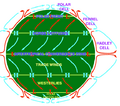Atmospheric circulation facts for kids
Atmospheric circulation is like a giant, global air conditioning system for Earth. It's the large-scale movement of huge amounts of air all around our planet. This movement helps spread heat from the warm parts of Earth to the colder parts.
The main reason for this air movement is the energy we get from the sun. The sun's rays heat up different parts of Earth unevenly. When the ground and oceans get warm, they heat the air above them. This warm air then moves, creating patterns of air circulation.
Even though the exact air patterns change a little each year, the main structure stays pretty much the same. Scientists have identified three main "cells" or loops of air movement: the Hadley cell, the Ferrel cell, and the Polar cell. These air masses are also affected by something called the Coriolis effect. This force makes moving air seem to curve or divert, usually towards the west in these large systems.
Contents
How the Sun Powers Air Movement
The sun sends out energy that warms our planet. Earth absorbs some of this energy, and some of it bounces back into space. The absorbed energy heats the land and oceans, which then warm the air above them.
- Warm air rises: When air gets warm, it becomes lighter and floats upwards. This is called convection.
- Cool air sinks: As warm air rises, it eventually cools down. Cool air is heavier, so it sinks back towards the ground.
- Air moves horizontally: When air rises in one place and sinks in another, it creates areas of high and low pressure. Air naturally moves from high-pressure areas to low-pressure areas, creating winds.
This constant rising, cooling, sinking, and moving of air creates the large-scale patterns we call atmospheric circulation.
Understanding the Three Main Air Cells
Scientists use three main cells to describe how air moves around the Earth. Each cell covers a different range of latitude (distance from the equator).
The Hadley Cell: Near the Equator
The Hadley cell is the strongest of the three cells. It happens in the areas closest to the equator.
- Hot air rises: The areas around the equator get a lot of direct sunlight. This makes the land and oceans very warm, and the air above them gets hot and moist. This hot, moist air rises high into the atmosphere.
- Low pressure zone: As the air rises, it creates an area of low pressure at the surface. This zone is known as the Intertropical Convergence Zone (ITCZ). It's often a band of clouds and heavy rain.
- Air moves and cools: Once the hot air rises, it moves away from the equator, both north and south. As it travels, it cools down.
- Air sinks and creates deserts: Around 30 degrees latitude (north and south of the equator), this now-cool, dry air sinks back down to the surface. This sinking air creates areas of high pressure. These high-pressure zones are where many of the world's large deserts and semi-deserts are found, because the sinking air is very dry and doesn't allow for much rain.
- Air returns to the equator: Once the air reaches the surface at 30 degrees latitude, it flows back towards the equator, completing the loop. These winds are known as the trade winds.
The Polar Cell: At the Poles
The Polar cell is found at the very top and bottom of the Earth, near the North and South Poles.
- Cold air sinks: The poles are extremely cold. The air here is very dense and sinks towards the surface, creating high-pressure areas.
- Air moves towards 60 degrees: This cold, sinking air then moves along the surface away from the poles, heading towards about 60 degrees latitude.
- Air rises and returns: Around 60 degrees latitude, this cold air meets warmer air coming from the Ferrel cell. The warmer air is forced to rise, and then it flows back towards the poles high in the atmosphere, where it cools and sinks again.
The Ferrel Cell: In the Middle
The Ferrel cell is located between the Hadley cell (around 30 degrees latitude) and the Polar cell (around 60 degrees latitude). It's a bit more complicated than the other two cells.
- Driven by other cells: Unlike the Hadley and Polar cells, the Ferrel cell isn't mainly driven by temperature differences. Instead, it's like a gear that's caught between the Hadley and Polar cells.
- Complex movements: Air in the Ferrel cell moves in a more complex way. It generally flows towards the poles at the surface and back towards the equator higher up.
- Westerly winds: The prevailing winds in this zone are generally from the west, which is why we often experience westerly winds in many parts of the temperate zones (like much of North America and Europe).
These three cells work together to move heat and moisture around the globe, influencing weather patterns and climates everywhere.
Images for kids
-
Long-term mean precipitation by month
-
The ITCZ's band of clouds over the Eastern Pacific and the Americas as seen from space
See also
 In Spanish: Circulación atmosférica para niños
In Spanish: Circulación atmosférica para niños





